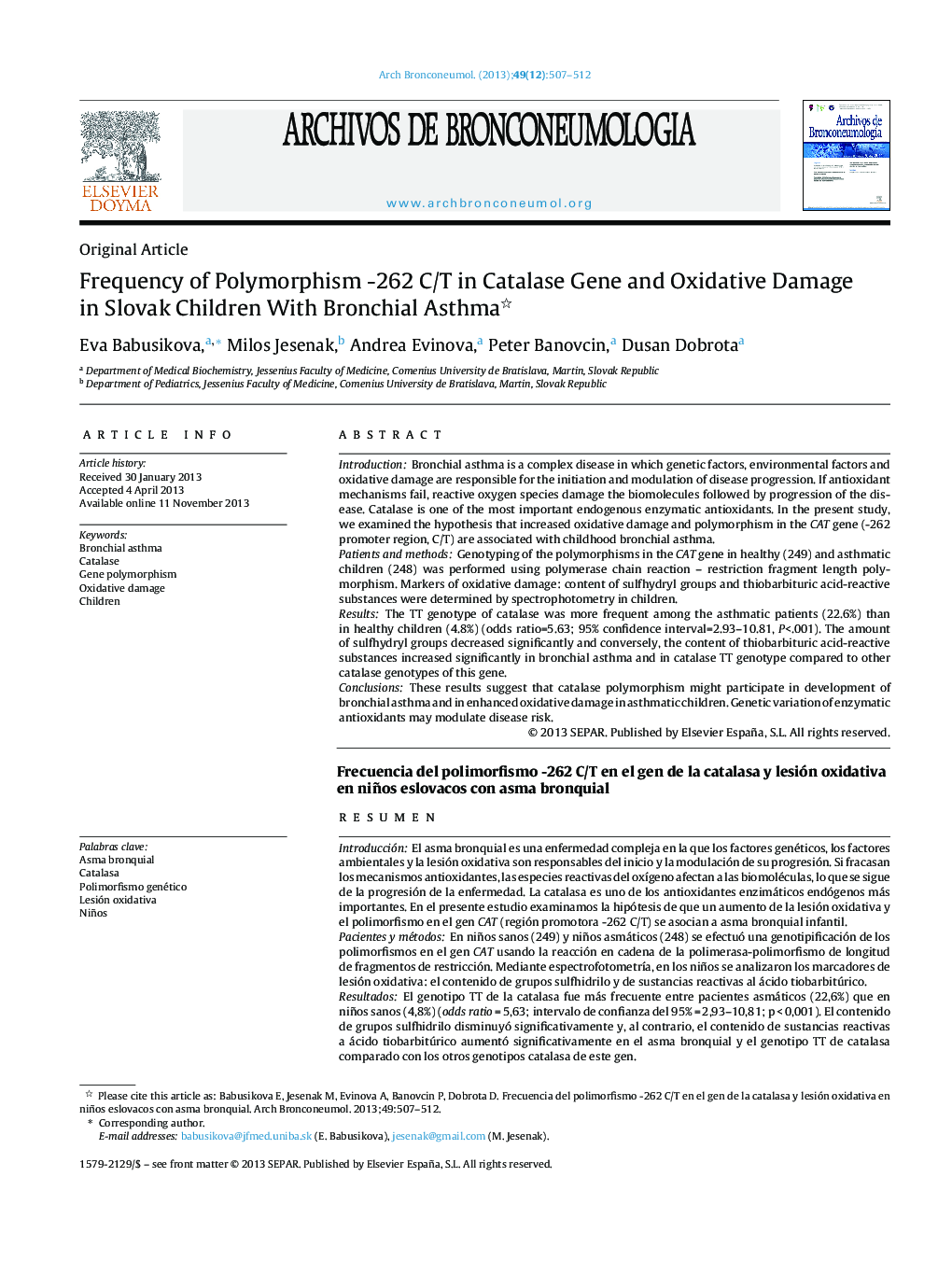| Article ID | Journal | Published Year | Pages | File Type |
|---|---|---|---|---|
| 4205787 | Archivos de Bronconeumología (English Edition) | 2013 | 6 Pages |
IntroductionBronchial asthma is a complex disease in which genetic factors, environmental factors and oxidative damage are responsible for the initiation and modulation of disease progression. If antioxidant mechanisms fail, reactive oxygen species damage the biomolecules followed by progression of the disease. Catalase is one of the most important endogenous enzymatic antioxidants. In the present study, we examined the hypothesis that increased oxidative damage and polymorphism in the CAT gene (-262 promoter region, C/T) are associated with childhood bronchial asthma.Patients and methodsGenotyping of the polymorphisms in the CAT gene in healthy (249) and asthmatic children (248) was performed using polymerase chain reaction – restriction fragment length polymorphism. Markers of oxidative damage: content of sulfhydryl groups and thiobarbituric acid-reactive substances were determined by spectrophotometry in children.ResultsThe TT genotype of catalase was more frequent among the asthmatic patients (22.6%) than in healthy children (4.8%) (odds ratio=5.63; 95% confidence interval=2.93–10.81, P<.001). The amount of sulfhydryl groups decreased significantly and conversely, the content of thiobarbituric acid-reactive substances increased significantly in bronchial asthma and in catalase TT genotype compared to other catalase genotypes of this gene.ConclusionsThese results suggest that catalase polymorphism might participate in development of bronchial asthma and in enhanced oxidative damage in asthmatic children. Genetic variation of enzymatic antioxidants may modulate disease risk.
ResumenIntroducciónEl asma bronquial es una enfermedad compleja en la que los factores genéticos, los factores ambientales y la lesión oxidativa son responsables del inicio y la modulación de su progresión. Si fracasan los mecanismos antioxidantes, las especies reactivas del oxígeno afectan a las biomoléculas, lo que se sigue de la progresión de la enfermedad. La catalasa es uno de los antioxidantes enzimáticos endógenos más importantes. En el presente estudio examinamos la hipótesis de que un aumento de la lesión oxidativa y el polimorfismo en el gen CAT (región promotora -262 C/T) se asocian a asma bronquial infantil.Pacientes y métodosEn niños sanos (249) y niños asmáticos (248) se efectuó una genotipificación de los polimorfismos en el gen CAT usando la reacción en cadena de la polimerasa-polimorfismo de longitud de fragmentos de restricción. Mediante espectrofotometría, en los niños se analizaron los marcadores de lesión oxidativa: el contenido de grupos sulfhidrilo y de sustancias reactivas al ácido tiobarbitúrico.ResultadosEl genotipo TT de la catalasa fue más frecuente entre pacientes asmáticos (22,6%) que en niños sanos (4,8%) (odds ratio = 5,63; intervalo de confianza del 95% = 2,93–10,81; p < 0,001). El contenido de grupos sulfhidrilo disminuyó significativamente y, al contrario, el contenido de sustancias reactivas a ácido tiobarbitúrico aumentó significativamente en el asma bronquial y el genotipo TT de catalasa comparado con los otros genotipos catalasa de este gen.ConclusionesLos resultados del presente estudio sugieren que el polimorfismo del gen de la catalasa podría participar en la aparición de asma bronquial y en el aumento de la lesión oxidativa en niños asmáticos. La variación genética de los antioxidantes enzimáticos podría modular el riesgo de la enfermedad.
